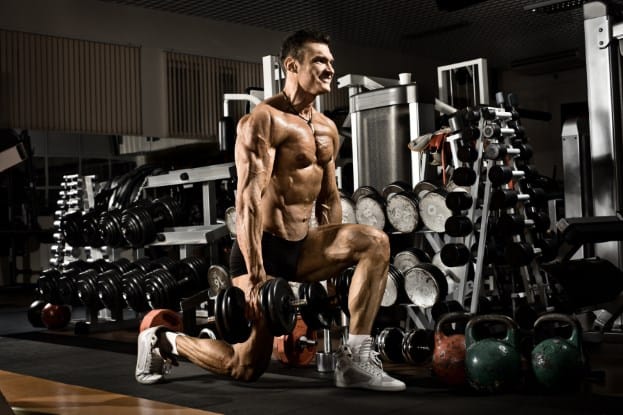You’re stuck between a rock and a hard place.
You want to build as much muscle as the Rock, but you move and feel like the Tin Man.
In your mind, there are two options.
The first option is to flip your joints the middle finger and go H.A.M. on your muscles. You’ll move worse than a rhino in a body cast, but, hey, at least you’ll like a stud, right?
Option two goes to the other end of the spectrum; treat your body as if it were an endangered bird. 30 minutes of foam rolling, 14 minutes of breathing exercises, strap/band assisted everything and 437 reps of those stupid rotator cuff exercises everyone does. You may not feel like you’re bulldozing your joints, but your pride is going to take a hit because you’re weaker, and have less muscle, than a ham sandwich.
Fortunately for you and your manhood, there is a third option. You won’t have to spend most of your workouts performing knock off physical therapy drills.
On the flipside, you won’t need to put your physical therapist on retainer.
Some simple tweaks to your programming, mindfulness of how your body moves and implementing the following methods to your training is all you need to continue getting strong while not crushing your joints.

Method 1 – Focus on Positioning
If you were to apply this method to your current training and life without making any other changes, I’d put a fat amount of money on the fact you’d see significant improvements in how your joints feel and the amount of muscle and strength you build.
The best way to think about positioning is to think of the alignment of your car. What would happen if your car’s alignment was FUBAR (fucked up beyond all recognition, for those not familiar with the saying)? Your car would be royally screwed at some point. Enough mileage with a crappy alignment would wear on the tires, shocks, etc.
Eventually, you’ll need to have some parts replaced or purchase a new car. Unfortunately, replacing parts on your body isn’t quite as simple as parts for a car. And, as far as I know, replacing your entire body isn’t an option.
Instead of having to replace the parts on the car every 10,000 miles, why don’t you fix the alignment, so the car can function how it was originally intended?
Same goes for body. Putting your joints into the proper positions will allow your muscles to function how they’re supposed to.
Here’s a short list of common issues you’ll have and easy ways to correct them.
Your rib cage is flipped up and shifted forward.
You’re probably walking around with the bottom of your ribs pointed toward the ceiling. Along with the entirety of your rib cage pushed forward over your toes.
There are plenty of reasons for this; poor breathing patterns, shitty trainers teaching movements incorrectly, being in a fast-paced/on-the-go society, etc.
The reasons why aren’t as important as correcting the issue.
The best way to get your ribs down and back is simple; exhale and reach.
When you exhale, get ALL of your air out. When you think you’re empty, keep going. I guarantee you have some more you can get out. You should feel your obliques (side of your abs) kick on. These big guys are lifesavers for your joints.
Once you have your exhale on point, we’re going to reach like you’re Stretch Armstrong. If you’re currently sitting, reach your hands out to the wall in front of you. Try to touch that son of a gun. Pay attention to your ribs when you reach. Did they shift backwards? Good. That’s what we need.
Pushing your center of gravity backwards puts your joints in their proper position to allow your muscles to do their intended jobs (i.e. your muscles work while sparing your joints).
Your pelvis has an anterior tilt.
To go along with the less than optimal position of your ribs, your pelvis is bound to be pointed toward the ground. If you’re been squatting and deadlifting for an appreciable amount of time, it’s going to be far worse than the average gym goer.
Like your elevated ribs, your pelvis position is off because of poor breathing patterns, performing less than optimal technique during exercises, etc.
Exhaling and reaching are going to help get your pelvis pulled back into a stronger position, but this guy needs extra love. Your hamstrings are going to dull out the extra love. These guys have a mechanical advantage to pull the back of your pelvis down, resulting in a stronger, safer position for all your joints.
Once you get your ribs and pelvis in a good position, your knees, back and other joints are going to thank you.
Issues you’ve been dealing will disappear or, at least, lessen.
All you must do is exhale, reach and find your hamstrings.
Method 2 – No More than 5 Reps
When you typically think of 5 reps, you’re thinking of moving some heavy ass weights. That is not the case here.
When you’re dealing with persistent aches and pains, going for a 5-rep max isn’t going to help your situation. Don’t worry, once you get your position and movement hiccups worked out, you’ll be slinging around your old 5-rep max like it’s a Chihuahua.
In this case, we’re talking about programming your workouts to be Alactic-Aerobic in nature.
Your alactic energy system is your strongest of the three. Think sprints, heavy weights and being explosive.
The aerobic system is weakest of the bunch, but it has the capability of going forever.
The idea behind Alactic-Aerobic workouts is to hit your strongest muscle fibers, but you’re only performing a few reps which keeps you away from massive amounts of fatigue. Lower levels of fatigue allows you to maintain your movement patterns and position (always comes back around to positioning).
To come up with your own Alactic-Aerobic workout, be sure to stick with the following guidelines:
- Stay between 3-5 reps per set
- Make sure you can breathe exclusively through your nose throughout (this ensure you’re staying in an aerobic zone)
- Choose a weight you can do 3-5 reps MORE than what is prescribed. Remember, you’re working on maintaining perfect positions with your ribs and pelvis, so accumulating a lot of fatigue with too much weight goes against what you’re trying to accomplish
- Limit how much you use barbells. This isn’t set in stone, but if you’re dealing with pain, swapping out your squats for DB Goblet Squats may be the right choice for you at the moment
To make it clear, here’s an example of an Alactic-Circuit:
| Week 1 | Week 2 | Week 3 | Week 4 | Rest | |
| 1A) DB Goblet Squat | 7×5 | 8×5 | 9×5 | 10×5 | 30 s. |
| 1B) Split Stance 1 Arm Row | 7×5 | 8×5 | 9×5 | 10×5 | 30 s. |
| 1C) Pushup | 7×5 | 8×5 | 9×5 | 10×5 | 30 s. |
Method 3 – Focus on Tempo
If there was ever an obvious method to improve your movement and how joints feel, it’s this one. Go slow to ensure you’re working what you’re trying to work (i.e. muscles, not joints).
Implementing a three second eccentric (the lowering of a squat or pushup) is the simplest way to add a form of tempo to your training.
Another way to go about it is to perform Eccentric Isometrics. You’ll do a three second eccentric followed by a 2-5 second pause in the bottom position. The pause will give you extra strength in what is generally your weakest position of an exercise. Not only that, it’ll force you to maintain your perfect position. You’re not moving for five seconds, so what else are you going to do then?
A personal favorite – I know you’ll love it too – Tempo Lifting. This involves not only a three second eccentric, but a three second concentric (coming up on a squat or pushup). Not only are you going slower than a snail scooting through molasses, but there is NO BREAK at the top or bottom of a movement. You’re keeping constant tension on the muscles. Plenty of quality of movement along with a skin melting burn.

Method 4 – More Unilateral Work
Squats, deadlifts and bench presses are great. They’re going to get you strong and add appreciable amounts of muscle to your frame.
But, they’re less forgiving on your joints than their unilateral cousins. Not only this, but, since you’re focusing on two limbs at a time, it’s harder to keep your ribs and pelvis in the correct position. There’s simply more to think about.
Lastly, there’s the obvious fact of you’re using less weight on these guys than a bilateral barbell lift. Again, more forgiving on the joints. Since you’ll be using lighter weights, this gives an opportunity to perform more overall volume to give your muscles a jolt of hypertrophy.
Here’s a list of my favorite unilateral exercises for you to try:
- Split Squats
- Rear Foot Elevated Split Squats
- Front Foot Elevated Split Squats
- Reverse Lunges
- 1 Arm Landmine Press with Reach
- 1 Arm DB Bench Press
- Alternating DB Bench Press
- 1 Arm Bench Supported Row
- Split Stance 1 Arm Bench Supported Row
The Painless Conclusion
Having cranky knees or a steel pipe for a back doesn’t mean you’re regulated to countless hours of foam rolling, emptying your pockets for your physical therapist or becoming a chiropractor’s star patient. You can adjust your training to help you with the aches and pains of life, instead of it causing them to worsen. It also doesn’t mean you’re forced to be weak and skinnier than a French fry. Implement the above methods you’ll be well on your way to jacked and pain-free.
About the Author
 Joe Huskey is a strength coach who specializes in training folks who move with more aches and pains than the Tin Man and fixing those who get screwed by crappy trainers. He also enjoys Ben & Jerry's a little too much and prefers the company of dogs more than most people. Follow him on Facebook.
Joe Huskey is a strength coach who specializes in training folks who move with more aches and pains than the Tin Man and fixing those who get screwed by crappy trainers. He also enjoys Ben & Jerry's a little too much and prefers the company of dogs more than most people. Follow him on Facebook.


